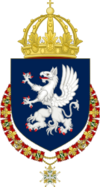User:Malay/SandboxV: Difference between revisions
No edit summary |
mNo edit summary |
||
| Line 67: | Line 67: | ||
==History== | ==History== | ||
The Union Assembly was formed via the [[Constitution of 1878 (Seredinia)|1878 Constitution]]; it had no direct predecessor, as previously the Seredinian government had consisted of local parliaments and councils directly treating with the Seredinian Sovereign. While the 1870 [[Treaty of Confederation (Seredinia)|Treaty of Confederation]] had set out directives to form a united legislature, the influence of the Sovereign as well as instability in the new Union delayed such a decision until 1878. It was made politically solvent directly upon its creation, with the Council and Duma being granted equal powers. | |||
Initially half of each body was directly appointed by the Sovereign. These powers were limited first in 1880, when the Duma became fully directly elected via {{wpl|first-past-the-post}} single-member districts. The Sovereign's appointments were fully done away with by the 1912 "constitution," which made the Federal Council indirectly elected rather than half of the body being directly elected and the other half appointed. | |||
==Components== | ==Components== | ||
Revision as of 00:21, 19 June 2019
Union Assembly of Seredinia Союзное собрание Серединии Soyuznoye sobraniye Seredinii | |
|---|---|
 | |
| Type | |
| Type | |
| Leadership | |
| Structure | |
| Seats | 802 members 200 Federal Councillors 602 Deputies |
 | |
Political groups | Majority
Other Opposition Parties
|
 | |
Political groups | Majority Government
Other Opposition Parties
|
| Elections | |
| Two-round system | |
Last election | 2018 Seredinian General Election |
| Meeting place | |
 | |
| Palace of Unity | |
| Website | |
| www.unionassembly.gov.su | |
The Union Assembly is the bicameral legislature of the Seredinian Union. It was formed via the 1878 Constitution, replacing the disparate and disconnected local assemblies across the region which had formed the confederate government for the previous eight years. It is the strongest governmental institution in Seredinia.
The powers of the Assembly are detailed in the aforementioned 1878 constitution, as well as the so-called January Constitution and the 1912 Union Constitution -- both actually being compiled amendments to the original 1878 document. The Assembly comprises two bodies; the Federal Council, which has 200 members, and the State Duma, which has at least 500 members and currently has 602. The Council is elected indirectly by the twenty-eight Federal Subjects, with representatives distributed by population. The Duma is elected via mixed-member proportional representation, with 250 single-member districts and a nationwide open party list which allows for numerous extra deputies through overhang and adjustment seats.
Members of the Assembly meet in the Palace of Unity in Zolodolina. While the Premier officially leads and sets the agenda of the State Duma, a President of that body as well as the Federal Council maintain moderating powers.
History
The Union Assembly was formed via the 1878 Constitution; it had no direct predecessor, as previously the Seredinian government had consisted of local parliaments and councils directly treating with the Seredinian Sovereign. While the 1870 Treaty of Confederation had set out directives to form a united legislature, the influence of the Sovereign as well as instability in the new Union delayed such a decision until 1878. It was made politically solvent directly upon its creation, with the Council and Duma being granted equal powers.
Initially half of each body was directly appointed by the Sovereign. These powers were limited first in 1880, when the Duma became fully directly elected via first-past-the-post single-member districts. The Sovereign's appointments were fully done away with by the 1912 "constitution," which made the Federal Council indirectly elected rather than half of the body being directly elected and the other half appointed.
Components
Premier
Committees of the Federal Council
Committees of the State Duma
Departmental: Business, Innovation and Skills Select Committee
Departmental: Communities and Local Government Select Committee
Departmental: Culture, Media and Sport Select Committee
Departmental: Defence Select Committee
Departmental: Education Select Committee
Departmental: Environment, Food and Rural Affairs Select Committee
Departmental: Foreign Affairs Select Committee
Departmental: Health Select Committee
Departmental: Home Affairs Select Committee
Departmental: International Development Select Committee
Departmental: International Trade Select Committee
Departmental: Justice Select Committee
Departmental: Science and Technology Select Committee
Departmental: Transport Select Committee
Departmental: Treasury Select Committee
Departmental: Work and Pensions Select Committee
Topical: Environmental Audit Select Committee
Topical: Belisarian Scrutiny Committee
Topical: Liaison Committee
Topical: Public Accounts Select Committee
Topical: Public Administration Select Committee
Topical: Arms Export Controls Committee
Topical: Regulatory Reform Committee
Topical: Select Committee on Statutory Instruments
Topical: Women and Equalities Committee
Topical: Petitions
Internal: Administration Committee
Internal: Backbench Business Committee
Internal: Finance and Services Committee
Internal: Members' Allowances Committee
Internal: Committee on Standards
Internal: Committee of Privileges
Internal: Procedure Committee
Internal: Committee of Selection